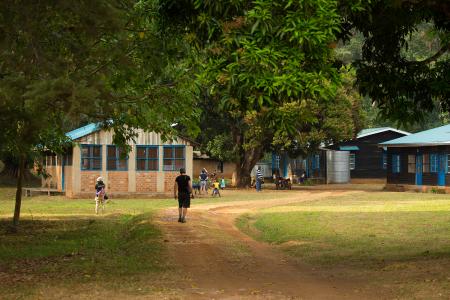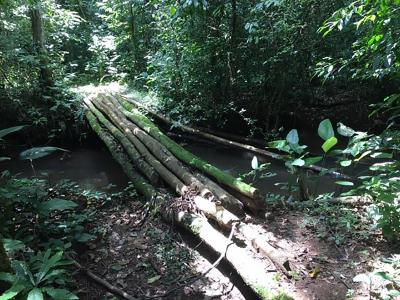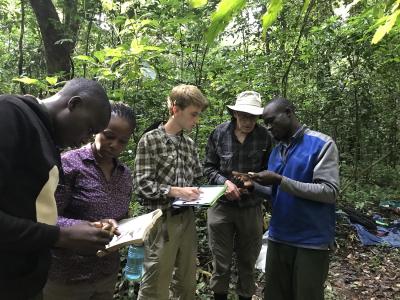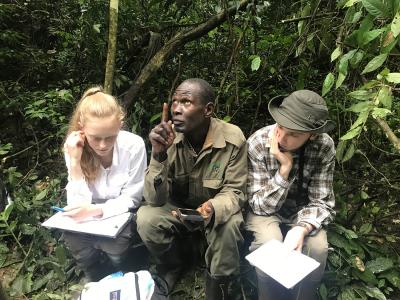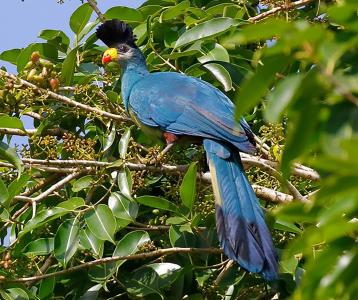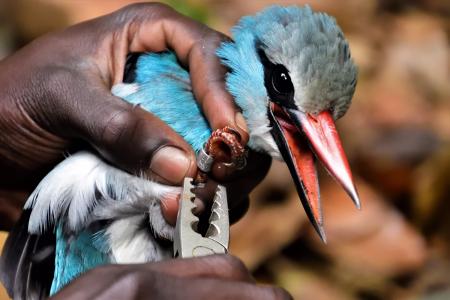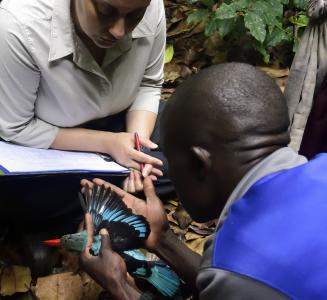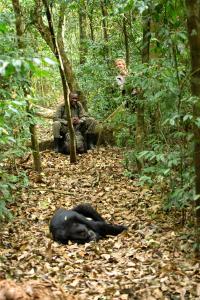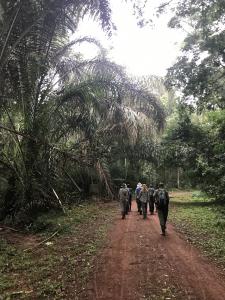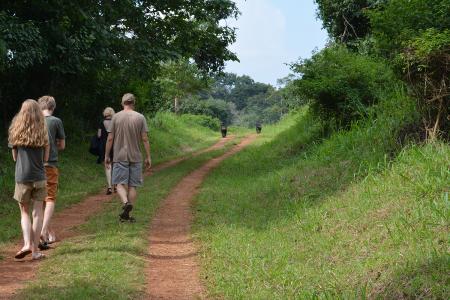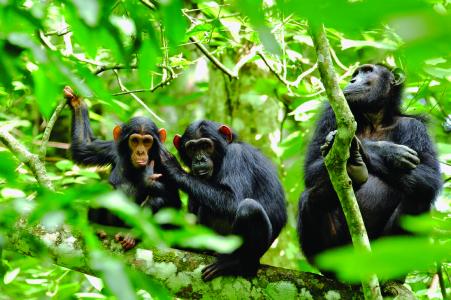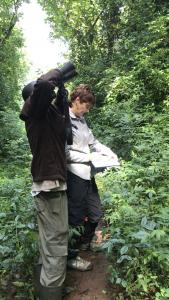Please read the following information carefully before leaving for your expedition.
Investigating Threats to Chimps in Uganda
Expedition Briefing
Quick Navigation: COVID-19 Safety | The Research | Research Aims | How You Will Help | Life in the Field | Accommodations and Food | Project Conditions | Essential Eligibility Requirements | Health and Safety | Project Risks and Precautions | Travel Planning | Additional Resources
Click on the images to view full size!
COVID-19 Safety
You are strongly encouraged to test for COVID-19 before traveling to your expedition, particularly if you are experiencing symptoms. Do not travel if you have tested positive, and call Earthwatch right away for the next steps. Please see earthwatch.org/covid-19 for more information.
Important requirements on this expedition: As we consider the different threats to chimpanzees in Uganda, we must address one of the world’s newest risks: COVID-19. There is still much scientists are learning about the impacts of COVID-19 on chimpanzee populations. With populations already deeply threatened, we cannot risk COVID-19 becoming another cause for their decline. To ensure that visiting Earthwatch teams do not increase the risk of COVID-19 exposure for chimpanzees, the first five days of each team will include research presentations, fieldwork training, and research tasks that do not engage directly with the primates. There will still be much to learn and important work to complete during these first days. The chimp research will then begin following this 5-day waiting period. Also, given the genetic similarities we share with these “closest living cousins,” we require that face masks be worn both during the waiting period when around others and afterward, EVEN WHEN OUTSIDE, when observing chimpanzees and other primate species
The Research
In Uganda’s Budongo Forest Reserve, as in any other ecosystem, the health of one species depends on everything around it. The 700–800 chimpanzees that thrive here are part of one of the largest populations in Uganda. These chimpanzees depend on the trees for food, and the trees, in turn, depend on a hospitable climate and healthy pollinator population. As fruit consumers and seed dispersal agents, birds are also important to forest ecology. Humans, too, rely on this forest: many who live at the forest’s edges make their living from it, and their ability to prosper depends on how healthy it stays.
But what happens when something in the ecosystem changes? On Investigating Threats to Chimps in Uganda, we hope to find out. For over 20 years, we have monitored tree phenology in the reserve—the timing of natural events like flowering, fruiting, and leaf shedding—and our data indicates a 15% reduction in the total number of trees that produce fruit in 15 years. Most of these trees are still alive but are simply not fruiting anymore. We don’t know precisely what has caused this reduction. Still, we know that it may have profound significance: it could make it harder for plants to grow and regenerate, alter the way chimpanzees, other primates, and birds forage, and, critically, cause additional conflict between humans and wildlife. We are also implementing a nutrient manipulation experiment and will expand our observations of plant/animal life cycle events to these plots.
Investigating Threats to Chimps in Uganda
Research Aims
On this project, you will help us investigate the causes and potential impacts of the tree phenology changes we have observed. We’ll look at how climate change and changing forest structure may have caused these changes. We’ll also explore how fruit-eating birds and primates, primarily chimps, have coped with the new fruiting pattern: Do they forage at different times or places? Is their dietary composition changing? Do they raid people’s crops more often? Are the changes in fruit production a “push factor”—driving the chimps and other primates to seek out other sources of food, or do the neighboring farmers’ gardens serve as a “pull factor,” drawing in these primates due to the concentration of highly nutritious food within a small area (garden). These questions can lead us to develop better forest management strategies and help us protect the well-being of chimps and people.
Because we have studied primates and trees in the Budongo Forest Reserve since the early 1990s (Plumptre 1996), we have an excellent opportunity to detect long-term change. Our tree phenology observations throughout the years can help us see how plant species respond to changes in climate (Tutin and Fernandez 1993), a critical question as we investigate what a warmer climate means for agriculture and plant diversity and health. To assess whether nutrient availability changes might influence fruit productivity, we are collaborating with Makerere University and scientists from several European universities in a large-scale experiment looking at the effects of added nutrients (nitrogen, phosphorus, and potassium) on forest plots and monitoring the impact on fruit production. We can also compare the foraging patterns we observed in the past with current foraging patterns, which helps us understand how life in this forest has changed and how primate species may adapt to the effects of climate change in tropical rainforests everywhere. We will also compare the current composition and abundance of frugivorous birds with the data collected in the early-mid 1990s to determine whether reduced fruiting also affects bird communities.
Investigating Threats to Chimps in Uganda
How You Will Help
You’ll contribute to three major components of our research:
PRIMATE FORAGING
While in the Budongo Forest Reserve, you’ll have the unusual opportunity to watch primates closely in their natural habitat. Working with field assistants, you will follow primates’ foraging behavior from around 7:00 a.m. until noon and from 3:00–6:00 p.m. Throughout the project, you’ll likely get to observe a few different primate species, including chimpanzees (Pan troglodytes schweinfurthii), blue monkeys Cercopithecus mitis), red-tailed monkeys (Cercopithecus Ascanius), and black and white colobus (Colobus guereza), and learn to identify the many different types of trees whose fruit they eat.
BIRD COMPOSITION
You will participate in mist-netting surveys of bird communities in selected forest blocks. The captured birds will be identified using bird guides and expert field assistants. With 360 species of birds recorded, the Budongo Forest is recognized as an important bird habitat in Uganda. The abundance of fruit-eating birds—including turacos and forest hornbills—will help shed light on the state of the fruiting trees and how it affects their populations.
TREE PHENOLOGY
Until 2011, we collected phenology data from 206 plots established along ten two-kilometer (a little over one mile) transects, the set paths along which we make our observations. Then, we increased the number of transects we monitored to 30 and the total number of plots along them to 607. This expansion allows us to research more forest types within the reserve, but it also means we need many more eyes in the field to complete our data collection on schedule each month. Your help is, therefore, invaluable as you walk transects with us, observe tree fruiting patterns, and take measurements of canopy openness in the research plots. We also monitor rainfall and temperature in each forest type to capture a full picture of the environment. This will enable us to understand why many tree species are no longer fruiting and investigate the likelihood of climate change influencing fruiting patterns.
In addition to determining the causes of reduced tree fruiting, we would like to understand how trees utilize their energy, given that they are reproducing less. Moreover, with increased atmospheric carbon dioxide, it is plausible that trees are responding by increasing their growth rate at the expense of reproduction. You will be helping us gain evidence for changes in forest processes due to increased atmospheric carbon dioxide levels. This will be done by measuring the forest ecosystem carbon budget both above and below ground to assess what changes in stem growth mean for overall ecosystem carbon storage and release.
Our involvement in each of the above research areas will vary throughout the year depending on the season and fruiting of the trees. Your team may not participate in all the above tasks, so we ask you to be flexible, as this is the nature of field research.
Investigating Threats to Chimps in Uganda
Life in the Field
Considering the different threats to chimpanzees in Uganda, we must address one of the world’s newest risks: COVID-19. There is still much scientists are learning about the impacts of COVID-19 on chimpanzee populations. With populations already deeply threatened, we cannot risk COVID-19 becoming another cause for their decline. To ensure that visiting Earthwatch teams do not increase the risk of COVID-19 exposure for chimpanzees, the first five days of each team will include research presentations, fieldwork training, and research tasks that do not engage directly with the primates. There will still be much to learn and important work to complete during these first days. The chimp research will begin following this 5-day waiting period. Also, given the genetic similarities we share with these “closest living cousins,” we require that face masks be worn both during the waiting period when around others and afterward, EVEN WHEN OUTSIDE, when observing chimpanzees and other primate species.
On this project, you will research the foraging behavior of monkeys and chimpanzees for three full days in your week. Your team will split into two to three groups, alternating between chimpanzee foraging and monkey foraging. Therefore, each volunteer will spend two days collecting data on the foraging behavior of chimpanzees (one day with a semi-habituated group and one day with a fully habituated group) and one day collecting data on the foraging behavior of monkeys (species vary in their habituation levels). “Habituated” animals are wild animals that have become accustomed to human presence to the extent that they perceive humans as part of their natural environment. However, please be mindful that chimpanzees, like all wildlife, are unpredictable in their range of patterns and behavior; on some days, the researchers do not see them.
The other two research days will involve a mix of tree growth, phenology, bird surveys, and crop-raiding research. This research will happen first, during the 5-day waiting period when chimpanzee contact and fieldwork are restricted, followed by the primate research days.
DAILY ACTIVITIES
Weather and research needs can lead to changes in the daily schedule. We appreciate your cooperation and understanding.
The first couple days of each team include an important waiting period where participants will participate in educational and informative lectures and training, engaging with various local field staff and scientists at the research station. These presentations and outdoor interactive demos will help prepare participants for fieldwork activities beginning on Day 4. Once the 5-day waiting period is complete and participants feel well and have received two confirmed negative COVID tests (1 rapid on Day 3 and 1 PCR on Day 5), primate fieldwork can safely begin on Day 6. Please see below for a detailed itinerary.
On some fieldwork days, the team may not return to the forest in the afternoon and will work in the camp lab to sort, compile, and profile samples collected and process and manage data. The team will alternate between activities, and you’ll receive a full schedule on arrival. Interactions with the local communities may occur in the afternoons.
ITINERARY
- Day 1:
- Morning: Rendezvous in Entebbe. Drive to Budongo Conservation Field Station, with a stopover at a shopping center on the outskirts of Kampala, to exchange money and buy any last-minute essentials.
- 3:00 p.m. Lunch in Masindi before arriving on site.
- 7:00 p.m. Team dinner and welcome orientation.
- Day 2: Morning presentations on the History of the Research Station, Risk Briefing and general Health Risks, and Project Research Objectives and Activities; Afternoon introduction to the camp facilities.
- Day 3: Introduction to phenology and primate foraging data collection methods; Volunteers conduct take-home COVID-19 rapid tests (required in packing list).
- Day 4: Birding and phenology fieldwork during the morning and early afternoon; Afternoon lecture from resident researcher
- Day 5: Birding and phenology fieldwork during the morning and early afternoon; Evening Chimpanzee Health Monitoring Program Talk
Participants complete COVID PCR test at a local facility.
- Days 6-7: Chimpanzee foraging fieldwork
- Days 8–9: Recreational days (e.g., resting at camp, a trip to Murchison Falls National Park, shopping in Masindi, Kinyara Pool and Bar, and own activities).
- Day 10: Monkey foraging fieldwork during the morning and early afternoon; conservation activities in neighboring local communities in the afternoon.
- Day 11: Snare patrol, snare setting, and working demonstration during the morning and early afternoon; debrief, cleaning, and preparations for travel home in the afternoon onwards.
- Day 12: Travel to Entebbe/Kampala at 9:00 a.m.
Tasks vary according to season. Researchers set the exact timetables within two weeks of each team once they know what data can be collected.
RECREATIONAL TIME
At the camp, you’ll have opportunities to relax and socialize. Researchers and other camp residents sometimes play volleyball or Frisbee in the evenings. Those keen to birdwatch can take an evening stroll to the Royal Mile, a 10- to 15-minute walk away. Twice a month, the administration hosts a dinner at camp to give the management, researchers, and volunteers a chance to interact and learn more about the work being done by different teams at the field station. During the dinners, we encourage participants to make presentations about any conservation-related topic (this could be something you have been involved with back home or a current project).
During weekends (non-working days), you may opt to go shopping at the local markets in Masindi, and you may have a chance to go out with the veterinary team for their periodic veterinary rounds in the local communities. You can also spend the day relaxing at local Kinyara Sugar Works, which has a swimming pool, bar, and table tennis facilities (per Earthwatch policy, please do not drink before swimming).
Murchison Falls National Park Visit (Optional): You may also opt to arrange a visit to nearby Murchison Falls National Park over these two days. You are responsible for arranging this visit—if elected.
As an added security measure and to ease logistics for our participants, Earthwatch has worked with the Lead Scientists to create a predetermined itinerary for a park safari. This package includes transportation to and from Budongo Conservation Field Station and an overnight stay at the Red Chili Rest Camp, located in the heart of the park. This tour package is offered through the DAMAKI GROUP OF COMPANIES LTD.
Participants may coordinate this optional trip by contacting DAMAKI directly at damakigroup@gmail.com. Pricing depends on group size and ranges from approximately $300–$1,000 USD per person (see pricing guide here). You may coordinate with your teammates or travel companion(s) on a group reservation or wait until arrival on-site to make arrangements. Though space may be more limited in the high season (June–September; December–January), late reservations are generally possible. When contacting DAMAKI, state that you are with the Earthwatch group staying at Budongo Conservation Field Station.
Given the heightened security situation in Uganda at this time, participants are strongly encouraged to choose this packaged tour option if they are visiting Murchison Falls. Those who choose to make alternative transport and/or accommodations arrangements apart from DAMAKI do so at their own risk and must sign an Earthwatch Recreational Activity Release Form before leaving the project premises.
IMPORTANT: Those who leave camp on the designated recreation days must take extra precautions in line with CDC COVID-19 Prevention Guidelines.
Investigating Threats to Chimps in Uganda
Accommodations and Food
* Please note that not every expedition has couples’ or singles' accommodations available. Please call or email Earthwatch to check availability before reserving your space(s) on the team.
SLEEPING
You’ll stay in the heart of the reserve at the Budongo Conservation Field Station, an opportunity that an ordinary tourist doesn’t have. The station has five residential houses, each accommodating up to six people (including research students, who may reside during your expedition). We host researchers worldwide, so you’re likely to meet a diverse group of people when you visit.
In the house, you’ll have a private bedroom with a bed, sheets, pillows, blankets, a mosquito net, and a reading desk and chair. We have two rooms with double beds for couples, and you can reserve one at no extra charge, depending on availability, through Earthwatch.
* Earthwatch will honor each person’s assertion of gender identity respectfully and without judgment. For both teen and adult teams, where logistics dictate single-sex accommodations or other facilities, participant placements will be made in accordance with the gender identity the participant specified on their Earthwatch Participant form and/or preferences indicated in discussions with Earthwatch.
BATHROOMS
You’ll share four on-site pit latrines. The station also has two showers connected to water tanks, and each evening, a staff member fills the water tanks and heats them to provide quick hot showers. Water for Budongo Conservation Field Station (BCFS) is harvested from the roofs during the wet season and stored in tanks around the camp. The tanks have taps at about half a meter (one and a half feet) off the ground for face and hand washing. In the dry season, water for showers, laundry, and cleaning is taken from the Sonso River. Please always be resourceful with water. Three staff members clean the rooms, showers, and toilets regularly. Please remember to bring a headlamp for using the latrines at night and general use for activities around the camp after dark and before sunrise.
ELECTRICITY
All rooms have solar electricity for lighting. There are three workspaces designated for charging laptops and other electronic equipment. Usually, we do not have power failures during the dry seasons (December through March and June through August) when the sun is constantly out. However, during the wet season, the cloudy, rainy weather limits the amount of solar energy available. We conserve power when necessary but also have a standby generator to charge equipment for the next day’s work.
Both the solar system and generator have a 240-volt output. The station has three-pin U.K.-type outlets.
Batteries are not recyclable in Uganda. Please take any used batteries back to your home country for proper disposal.
PERSONAL COMMUNICATIONS
The field station has access to mobile telephone networks. You can easily buy local network mobile phone cards for your mobile phone; this is recommended as the most affordable option.
We have dial-up Internet access, but the connection is often weak. If you bring a laptop, you can purchase your mobile modem for roughly 100,000 Ugandan shillings (about US$40) for a one-month subscription. Or you can borrow the camp’s mobile Internet hook-ups if researchers are not using them.
Please note: Personal communication with outsiders is not always possible during an expedition. Earthwatch encourages volunteers to minimize outgoing calls and immerse themselves in the experience; likewise, family and friends should restrict calls to urgent messages only.
DISTANCE TO THE FIELD SITE
You’ll stay in the heart of Budongo Forest, practically jumping out of bed and into the forest for work each day.
The distance from sites varies by activity:
You’ll have to walk up to 3 kilometers (about 2 miles) to reach phenology transects. The transects are two kilometers long (around a mile), and you’ll have to walk between them for a total daily walking distance of six to 10 kilometers (about 3–6 miles).
The primate groups we observe for the foraging study frequent areas within a radius of 5–7 kilometers (3–4 miles) from camp. Depending on where the primates are feeding, we will walk between 100 meters and three kilometers (300 feet to 2 miles) to the observation sites for monkey groups and between 1–7 kilometers (0.5–4 miles) for chimpanzee groups.
The community study sites may be visited; these are 4 kilometers (2.5 miles) from camp. You’ll be driven to the end of the road en route to each community, but you may need to hike some distance over uneven terrain to reach the communities, as many do not have direct road access.
FOOD AND WATER
Staff members will prepare most of your meals. Depending on your preference, you’ll get to make your own (hot or cold) breakfast; we can purchase the most common Western breakfast foods in Masindi. You can help prepare evening meals if you like.
Most ingredients come from local markets and shops, which we visit weekly to pick up supplies. You can generally give input into what food we purchase and help with the mid-team shopping trip to replenish supplies.
TYPICAL MEALS
Below are examples of the foods you might eat. Variety depends on availability. Volunteers must be flexible.
- Breakfast: Cereal/oats, coffee and tea, bread, eggs, and chapati (flat Indian bread cooked on a griddle)
- Lunch: Sandwiches, chapati, rice, mixed vegetables, egg, fruit
- Dinner: Rice, chapati, potatoes, spaghetti, beans, beef, fish, peanuts, cowpeas (also known as black-eyed peas), eggs, and assorted fresh fruits and vegetables. You’ll also eat local dishes like cassava, matooke (stewed bananas), and ugali (also called posho—a cornmeal bread).
- Snacks: You may purchase additional snacks at your own expense when shopping in town. Options include chocolate bars, chips/crisps, and juice.
- Beverages: On selected nights, sodas will be served. They can be purchased locally if you wish to have beers and/or sodas on other days.
- Water: You’ll get sanitized drinking water at camp, either from harvested rainwater or river water. Water is boiled over the wood stove before drinking, so it tastes slightly smoky. DO NOT drink water from the tap or any other source, and avoid ice.
SPECIAL DIETARY REQUIREMENTS
Please alert Earthwatch to any special dietary requirements (e.g., diabetes, lactose intolerance, nut, other food allergies, vegetarian or vegan diets) as soon as possible, and note them in the space on your volunteer forms.
Accommodating special diets is not guaranteed and can be very difficult due to the availability of food, the location of field sites, and other local conditions. We can accommodate vegetarian diets, but vegan diets may be difficult to manage.
Investigating Threats to Chimps in Uganda
Project Conditions
The following information is as accurate as possible, but please remember that conditions may change.
You’ll encounter generally flat terrain, though there are steep valleys you may have to traverse on occasion, and one of the chimpanzee groups under study is in a hillier forest area. Some parts of the forest have dense undergrowth, but we have an established and well-maintained grid system within the forest, along which the research teams walk to collect data. However, when following primates, the research team may move off the grid; when this happens, the team will have to walk through a dense tangle of vegetation, climb over fallen logs, bend under hanging branches, and occasionally cross shallow streams. Newly cut sections of the grid system have more uneven terrain and unclear debris to walk over.
GENERAL CONDITIONS
Please visit wunderground.com and search your project location for weather and region-specific information.
Investigating Threats to Chimps in Uganda
Essential Eligibility Requirements
All participants must be able to:
- Submit to COVID-19 testing on Days 3 and 5 of the expedition with negative results. Participants must monitor health for signs of illness, including COVID-19 and flu virus, throughout the team.
- Most days, hike for approximately 6–10 kilometers (approx. 3–6 miles) each day across gentle slopes.
- One of the chimpanzee groups you’ll study has a large home range. The physical activity required to track this group is much higher than is necessary to track other groups (though there will be opportunities to stop and rest). When following this group, you must be able to hike from 10–20 kilometers (6–12 miles), depending on how active the chimps are, over uneven, sometimes steep, terrain.
- Hike through dense tangles of vegetation.
- Step or climb over vegetation and fallen trees.
- Traverse small streams, sometimes using logs, which require good balance, to reach some research areas.
- Carry basic research equipment, including GPS handsets, plastic containers for trapping insects, data sheets, drinking water, and sometimes a packed lunch weighing up to three kilograms (seven pounds).
- Enjoy being outdoors all day in all types of weather, often exposed to heat and sun for long periods.
- Make visual observations of animals feeding high in the canopies, approximately 40 meters (131 feet) high. Binoculars may be provided, but it is generally advisable to carry your own.
- Get yourself up and down out of a vehicle and ride, seated with a seatbelt fastened, for about five hours on arrival and departure days. Be comfortable for shorter driving periods daily. Roads are mainly paved for longer travel routes, but for shorter periods, travel is off-road.
- Squat low to the ground with no support to use the pit toilets.
- Get low enough to use water from rainwater storage tanks for face- and handwashing, which have taps at about half a meter (one and a half feet) from the ground.
- Follow verbal and/or visual instructions independently or with the assistance of a companion.
- Take an active role in one’s safety by recognizing and avoiding hazards if and when they arise (including, but not limited to, those described in Earthwatch materials and safety briefings). Always comply with project staff instructions and recommended safety measures.
- Be able to effectively communicate with the staff if they are experiencing distress or need assistance.
- Be able to get along with a variety of people from different backgrounds, often in close proximity, for the duration of the team.
- Be comfortable being surrounded by a language and/or culture that is not your own.
Investigating Threats to Chimps in Uganda
Health and Safety
EMERGENCY COMMUNICATIONS
Staff members have mobile phones, although not all forest areas have a signal. We also carry VHF radios for in-forest communication between research teams.
Earthwatch has a 24-hour, 7-day-a-week emergency hotline number. Someone is always on call to respond to messages that come into our live answering service.
IMMUNIZATIONS & TRAVEL VACCINATIONS
Please be sure your routine immunizations are up to date (for example, diphtheria, pertussis, tetanus, polio, measles, mumps, rubella, and varicella) and that you have the appropriate vaccinations for your travel destination. Medical decisions are the responsibility of each volunteer and their doctor. Visit the Center for Disease Control and Prevention or the World Health Organization for guidance on immunizations.
If traveling from countries or regions where yellow fever is endemic, you must have a certificate of vaccination.
Staying up to date with your COVID-19 vaccinations, including receiving booster doses, as applicable, is strongly encouraged.
Investigating Threats to Chimps in Uganda
Project Risks and Precautions
LGBT+
As of May 30, 2023, Uganda has enacted legislation that imposes severe penalties, including imprisonment and, in some cases, capital punishment, for same-sex sexual activity and advocating or promoting LGBT+ rights. There have been reports of violence against LGBT+ people, including some committed by state officials. If you identify as LGBT+, we recommend prioritizing personal safety and informed decision-making when traveling. More information about this law can be found by visiting the "Local laws and customs'' section of GOV.UK's (www.gov.uk) Uganda travel advice page and the Uganda International Travel Information page on state.gov.
Earthwatch does not support the anti-homosexuality regulations in Uganda, but we do support the safety and well-being of our participants and field staff. While we wish we did not need to make such recommendations for their safety, authorities recommend travelers avoid publicly identifying themselves as LGBT+ at all times when in-country, including same-sex public displays of affection. All our time and funding on this project goes to the research needs of the chimpanzee communities and support staff working to protect them.
TRANSPORTATION
The research area has dirt, gravel, and corrugated roads, which can be bumpy, dusty, muddy, and slippery depending on weather conditions. Deep ruts in the road can cause the vehicle to lurch. The road from Entebbe to Masindi is paved and in fairly good condition, but road hazards still include fast and reckless drivers, livestock and wildlife on the road, and poor or no lighting on roads. We will not drive at night except in case of emergency. All project vehicles will carry means of communication, first-aid kits, and water.
Participants may not drive. Always wear seat belts when available and remain seated when vehicles are in motion. Many people ride motorbikes in Uganda; Earthwatch participants are not insured to travel by motorbike and must not do so. Public transport hazards include poor vehicle maintenance and reckless driving. We recommend that you use special hire vehicles or taxis, ensure they have seatbelts, and do not use public transport. Do not hesitate to ask drivers to slow down or get out and travel with another driver if you feel uncomfortable.
HIKING/WORKING IN THE FOREST
You’ll encounter fallen trees; do not jump over large logs; walk around them. Terrain may be uneven and slippery when wet. Newly cut sections of trail sometimes have sharp roots sticking up from the ground. Always wear sturdy boots with good tread, and never run.
You can easily get lost—always enter the forest with a staff field assistant and carry a whistle. The field assistant will have a compass, and we will train you to understand the forest grid system.
PLANTS/ANIMALS/INSECTS
Baboons, monkeys, and sometimes chimps may enter the camp. Baboons try to scavenge food, so you must always keep your windows closed. Also, ensure that all doors in camp are shut and bolted behind you. If you see an animal in camp, be calm and do not approach it. When you arrive, you’ll receive a full briefing on appropriate behavior around wild animals—always follow staff instructions.
Chimpanzees occasionally carry out dominance displays around researchers—should this occur, stay calm and follow staff instructions. Do not run.
Do not eat any wild plants—some are toxic. Some also irritate when you come in contact with them; wear long sleeves and pants to avoid this.
Malaria is common. Bring and take malaria prophylaxis and wear long sleeves and pants to protect from mosquito bites (and other biting insects). The project accommodations provide mosquito nets—use them. Also, always use insect repellent, particularly at dawn and dusk when mosquitoes and other insects are more prevalent. You may also encounter other biting and stinging insects. If you have allergies to stings or bites, clearly indicate them on your medical form and bring any appropriate medication. Inform field staff where you keep them when you arrive.
Other insects you might encounter include ants—many in camp, some of which bite. You’ll soon learn which areas to avoid. Be especially careful when wearing flip-flops. Jigger flies are generally found in villages, and you best avoid them by wearing closed-toe shoes.
Mango flies, which burrow under human skin to lay larvae, are present in Uganda. You can best avoid them by having camp staff iron all clothing after washing and before wear and by hanging your laundry to dry indoors. NOTE: Camp staff will not wash undergarments as this is considered private. Volunteers should wash their underwear if necessary and dry them in their rooms.
We will brief you on how to avoid the venomous snakes that live in the area. Only enter the forest with a staff member; immediately alert a staff member if you see a snake.
CLIMATE/WEATHER
Generally, the forest's interior is comfortably cool, but it can get extremely hot outside the forest (up to 35°C), which may cause sunburn and dehydration. Avoid prolonged sun exposure, wear protective clothing and a hat, and drink fluids.
We may occasionally get rained on in the field. Always carry rain gear in your backpack and wear sturdy, waterproof boots with good tread. Poor weather may cause branches to fall. We will stop forest research activities if severe weather conditions persist.
FIRE
You will stay and work in wooden buildings and must follow strict fire prevention protocols. Smoking is prohibited at the accommodations and field sites.
COOKING
You can help with cooking at the camp, which is optional. There is a risk of burns from the gas or wood cookers and food poisoning. Ask for help if you’re using the wood cooker, and always wash your hands before preparing food.
PERSONAL SECURITY
Political demonstrations sometimes take place throughout Uganda. Such demonstrations have, on occasion, turned violent. Avoid protests, demonstrations, and large public gatherings; do not stop to photograph them.
Terrorism is also an ongoing and indiscriminate threat in Uganda; several bomb attacks have occurred in the last few years. Recent attacks by rebel groups—particularly concentrated in southwestern Uganda—have caused deaths and serious injuries. Participants are encouraged to limit travel in Uganda before or after the expedition. Particular caution should be exercised in border regions, areas frequented by tourists, and crowded areas—such as Kampala—as these are at increased risk. Should you wish to arrange other activities, we strongly recommend checking advice from your government travel advisory service before making your plans.
In the unlikely event of banditry, do not try to defend property—personal safety should come first. Such activity tends to happen in major cities and border regions and is not likely at the project site. However, always stay alert and aware, particularly when traveling through Entebbe and Kampala to the project site, and follow advice from local authorities and hotel personnel. In public areas, particularly tourist destinations, do not flaunt money or valuables; always be aware of your surroundings and belongings. Leave unnecessary valuables at home. Petty crime rates are high in larger cities. We strongly advise you not to walk alone, especially at night and in urban areas. The field station is fairly secure, and we often leave doors unlocked. Nonetheless, it is always best practice to keep valuables hidden.
A night guard is present at the field station, and a guard is stationed at the forest reserve entrance. Teams will travel in convoys (at least two vehicles) between the Entebbe rendezvous and the field station. An unarmed security guard will also accompany this transfer for the additional protection of research teams.
SWIMMING IN OR NEAR WATER
The forest has some streams and small rivers, over which logs may have been put to enable crossing. These logs can be slippery, so cross carefully and test the log’s strength before crossing. We will not cross streams deeper than ankle height via the riverbed.
Follow standard swimming pool rules if visiting the Kinyara Sugar Works pool on the recreational day. We advise you to refrain from taking any boats or ferries on Lake Albert or Lake Victoria due to their poor safety records and the likelihood of overcrowding.
DISTANCE FROM MEDICAL CARE
The nearest clinic is at minimum a 25-minute drive from the project site, and the closest fully equipped hospital is in Kampala, at least four hours away. Transportation times may vary due to road conditions, traffic, weather, etc. If you have a chronic condition that could require immediate medical care (e.g., heart conditions, kidney problems, severe asthma, etc.), or if you are pregnant, please discuss your participation on this expedition with your physician.
DISEASE
Zoonotic diseases (those transmissible between humans and animals; the flu is most virulent) are of major concern. We’ve not had any cases in the past, but we know that the risk of disease transmission is high since we’re working with habituated chimpanzees. We have strict research protocols to temper this risk.
Malaria is highly endemic in most parts of Uganda, and there is a risk of contracting the disease. Traveler’s diarrhea affects many international travelers.
Other diseases found in Uganda include ebola, dengue fever, filariasis, leishmaniasis, onchocerciasis (river blindness), trypanosomiasis (carried by insects), schistosomiasis (a parasitic infection), chikungunya, West Nile virus, tuberculosis, HIV, hepatitis B and C, STIs, meningococcal meningitis, plague, and polio. Please see the U.S. Centers for Disease Control and Prevention (cdc.gov) or the World Health Organization (who.int) websites for more information on these conditions and how to avoid them.
You can decrease your risk of many diseases by avoiding mosquito bites, practicing good hygiene, and drinking only bottled or filtered water. Tap water in Uganda is not safe to drink.
If you feel ill once you return from your trip, inform your doctor that you have recently returned from a tropical region.
A few notes on vaccinations and treatment:
- Malaria: Uganda is a malarial area, and researchers have contracted the disease. Local Plasmodium strains are thought to be resistant to Paludrine and Chloroquine. Before arriving in Uganda, you should speak to a physician and bring the best antimalarial for you. Both Doxycycline and Mefloquine (Lariam) are available in Uganda. Malarone is not available.
- Rabies: Vaccinations are generally recommended for this expedition, given the potential contact with wildlife and the prevalence of loose and stray dogs. The rabies pre-exposure vaccination consists of three doses over 28 days. Please consult your physician or travel health clinic before your expedition to ensure you have time for the full vaccination series. If you have previously been vaccinated, a booster shot may be required.
Whether you have been vaccinated or not, always avoid loose and stray dogs. The pre-exposure vaccination does not eliminate the need for post-exposure medical attention and treatment. Still, it does provide additional protection against the disease in the event of a delay in treatment. In addition, bites or scratches should be immediately and thoroughly washed with soap, clean water, and a topical povidone-iodine solution or ethanol.
Note: Globally, there is currently a shortage of the standard rabies immune globulin used to treat bite victims who have NOT had the pre-exposure vaccine against rabies. In 2013, some key hospitals in Uganda had no availability of this immune globulin. Please consider this when discussing the vaccination with your doctor.
- Tuberculosis: Volunteers returning from developing countries may wish to have a (PPD)-tuberculin skin test to screen for potential infection.
- Yellow Fever: A vaccine against yellow fever is available, although pregnant women and immune-compromised individuals cannot be vaccinated.
Your home country may require a certificate of vaccination for re-entry if you travel to an area where yellow fever is endemic.
Note: In recent years, there has been a shortage of the yellow fever vaccine across the US. You should discuss the vaccination and availability in your area with your doctor as soon as possible.
TRANSFER OF DISEASE TO HABITUATED PRIMATES
We take the health and safety of the fauna of Budongo Forest very seriously. COVID-19, or even a simple cough or cold, could have a devastating effect on wildlife and potentially on BCFS operations. It is your responsibility to arrive in good health and have your routine vaccinations up to date. BCFS may require you to provide proof of vaccinations. Suppose you suffer from a medical condition or allergies. In that case, you must ensure that these are listed on the Health section of your Earthwatch Participation Form to ensure proper arrangements can be made. There is a 5-day waiting period between the day your Earthwatch team begins and the day you are allowed into the forest for primate work to ensure that you have not picked up any illnesses, which could then be transmitted to the forest fauna. We will schedule tasks; accordingly, you will begin with phenology and pollinator work and only move on to the primate monitoring once project staff are satisfied that there is no possibility that you are carrying any flu-like virus. Should you become ill during the project, you cannot continue with primate monitoring work; however, in some cases, you may be permitted to work on other research tasks if you are sufficiently well and your illness is confirmed not to be COVID-19.
RISK OF COVID-19 OR OTHER RESPIRATORY ILLNESS
Earthwatch strongly encourages you to take precautions to help protect yourself and others from common viral respiratory illnesses, including COVID-19, flu, and RSV: stay up to date with your vaccinations; wash your hands frequently; take steps to improve air quality, for example, by increasing ventilation indoors or gathering outdoors; and use preventative measures to limit the spread if you are sick.
Persons with a higher risk of severe respiratory illness should consult their healthcare provider before participating.
Investigating Threats to Chimps in Uganda
Travel Planning
RENDEZVOUS LOCATION
Entebbe, Uganda
We strongly advise volunteers to fly into Entebbe a day before the rendezvous, arriving on a morning or early afternoon flight where possible to avoid needing to take local transport after dark. This will give you time to rest and prepare for the next day’s travel to the field.
Please Note: Due to heightened security risks, participants are advised to limit travel in Uganda before or after the expedition. Should you choose to arrange other activities, we strongly recommend checking advice from your government travel advisory service before making your plans. Particular caution should be exercised in border regions, areas frequented by tourists, and crowded areas—such as Kampala.
IMPORTANT: You may be required to obtain a visa to enter Uganda before you travel. Refunds will not be made for volunteers canceling due to not obtaining their visa in time to meet the team at the rendezvous. Contact your nearest Ugandan embassy or consulate to find out how to apply. Please note this process can take weeks or even months. We strongly recommend using a visa agency to expedite and simplify the process. You can find up-to-date visa requirements via the following site: travisa.com.
Specific travel planning details will be provided in your Earthwatch Expedition Logistics Document. This document can be found in your MyEarthwatch Portal once you enroll. Please do not book travel arrangements—such as flights—until the Expedition Logistics Document matching the current year has been published to your portal account.
ABOUT YOUR DESTINATION
Earthwatch strongly recommends that travelers investigate their destination before departure. Familiarity with the destination’s entry/exit requirements, visas, local laws, and customs can ensure smooth travel. The U.S. Department of State's Traveler’s Checklist and Destination Guides are helpful resources. For LGBTI travelers, the U.S. Department of State's LGBTI Travelers page contains many helpful tips and links.
COUNTRY AND PROJECT ENTRY REQUIREMENTS
You are responsible for reviewing and abiding by your destination's entry/exit requirements.
Entry visa requirements differ by country of origin, layover, and destination and do change unexpectedly. For this reason, please confirm your visa requirements at the time of booking and again 90 days before travel. Please apply early for your visa (we recommend starting six months before the start of your expedition). Refunds will not be made for volunteers canceling due to not obtaining their visa in time to meet the team at the rendezvous. You can find up-to-date visa requirements at the following website: travisa.com.
If a visa is required, participants should apply for a TOURIST visa. Please note that obtaining a visa can take weeks or even months. We strongly recommend using a visa agency to expedite and simplify the process.
Investigating Threats to Chimps in Uganda
Resources
ARTICLES
- Reynolds, V. (2005). The Chimpanzees of the Budongo Forest: Ecology, Behavior, and Conservation. Oxford University Press.
- Briggs, P. 2010. Bradt Travel Guide: Uganda. (6th edition). This guide is highly readable and informative. We especially recommend the Natural History and Practical Information sections.
PROJECT-RELATED WEBSITE
LITERATURE CITED
- Biesmeijer J.C. S. P. M. Roberts, S.P.M., Reemer, M., Ohlemuller, R., Edwards, M., Peeters, T., Schaffers, A.P., Potts, S.G., Kleukers, R., Thomas, C. D., Settele, J., Kunin, W. E. (2006). Parallel Declines in Pollinators and Insect-Pollinated Plants in Britain and the Netherlands. Science 313, 351-354.
- Plumptre, A. J. (1996). Changes following 60 years of selective timber harvesting in the Budongo Forest Reserve, Uganda. Forest Ecology and Management 89:101-113.
- Tutin, C. E. G. & Fernandez, M. (1993). Relationship between minimum temperature and fruit production in some tropical forest trees in Gabon. Journal of Tropical Ecology, 9, 241-248.
Investigating Threats to Chimps in Uganda
Sign up for the Earthwatch Newsletter
Be the first to know about new expeditions, stories from the field, and exciting Earthwatch news.
.
.
.
